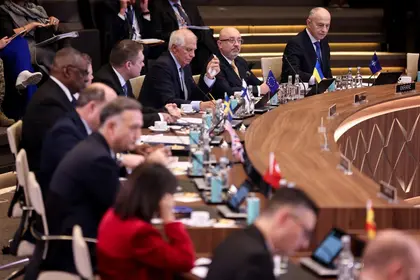Ukraine’s Western backers will meet at NATO headquarters in Brussels for a second day on Wednesday as they look to speed up deliveries of ammunition and arms to Kyiv ahead of an expected escalation of fighting in the coming weeks.
What is Ukraine hoping for?
JOIN US ON TELEGRAM
Follow our coverage of the war on the @Kyivpost_official.
After securing pledges on heavy tanks and longer-range missiles, President Zelensky has been pushing for Ukraine’s allies to send fighter jets.
On a rare trip abroad last week, he made a speech in Britain’s historic Westminster Hall where he said: “I appeal to you and the world... for combat aircrafts for Ukraine, wings for freedom.”
The timing of the gathering of defense ministers is critical – just under a year into the war, NATO says Russian President Vladimir Putin appears to be starting a broader new offensive in east Ukraine.
“We see Russia introducing a number of new troops to the battlefield,” U.S. Secretary of Defense Lloyd Austin said on Tuesday.
“Many of those troops are ill-trained and ill-equipped, and so their casualty rate has been really high.”
Austin said Ukraine was looking to turn the tide on the battlefield to gain momentum, and that he expected Kyiv’s forces to launch their own counter-offensive in the spring.
Was there any movement on fighter jets?
As we’re only halfway through the two-day meeting, no firm commitments have yet been made, but offers from Ukraine’s allies to send F16 fighter jets still appear to be a long way off.

Kyiv Hit by Massive Drone Attack as Russian Strikes Target Multiple Ukrainian Cities
Austin did make a broad statement on Tuesday, saying: “We will provide the Ukrainians with the means to hold out and advance during the spring counter-offensive.”
What does this actually mean?
Austin mentioned artillery, anti-aircraft defenses and armor, but not combat aircraft.
The possibility of sending F16 fighter jets to Ukraine was not even on the table at the meeting, Estonia’s defense minister told Kyiv Post on Tuesday.
Hanno Pevkur said: “It is not on the table today.”
However, when referring to ongoing programs to provide Ukrainian troops with training on other weapons systems, such as Leopard and Challenger tanks, Pevkur added: “At this moment, we are more concentrated on how we can increase the number of trained people.”
This was echoed by German Defence Minister Boris Pistorius, who said “the issue of air defense and the issue of ammunition resupply are much more important at the moment than the discussion about combat aircraft.”
His Ukrainian counterpart Oleksiy Reznikov agreed that the priorities were to protect his country’s skies, bolster promised tank supplies and ensure ammunition stocks.
“Tomorrow’s program is just as busy,” Reznikov said on Facebook on Tuesday evening. “We will devote more time to tanks.”
What about ammunition?
As Kyiv Post explained yesterday, Ukraine and its allies are facing an ammunition problem as the fighting is consuming vast quantities of ammo, straining stockpiles and industries on both sides of the confrontation.
NATO chief Jens Stoltenberg has warned that Kyiv’s current rate of expenditure was “many times higher” than the output in NATO countries. Allies continue to raid their shelves for the rounds – especially 155mm shells – that Ukraine is firing by the thousands each day.
NATO is scrambling to get its factories to pump out more, and allies are eyeing plans for joint weapons purchases, higher defense spending and longer-term contracts.
Pistorius said Berlin had signed a deal with manufacturer Rheinmetall to restart production of ammunition for Gepard air defense guns sent to Ukraine.
France and Australia also announced they would produce 155mm artillery together, while the Pentagon announced a $552 million contract with two arms companies to produce 155mm shells for Kyiv.
The first US deliveries are expected in March.
Norway’s government said Tuesday it would donate eight of its Leopard 2 tanks to Ukraine, fulfilling a previous commitment and joining a slew of Western countries to pledge heavier weapons to Ukraine.
What’s happening on the front lines right now?
On the ground in eastern Ukraine, an AFP team heard heavy outgoing artillery fire toward Russian lines around the city of Bakhmut, the main target for Moscow’s attacks.
Ukrainian officials have recently restricted access to the area for aid workers, sparking speculation Kyiv’s forces could be getting ready to withdraw after a grueling months-long battle.
But the head of Russia’s Wagner mercenary group said the fight for the symbolic prize was far from over as Ukraine continued to defend house to house, despite claimed Russian gains in nearby villages. “Bakhmut will not be taken tomorrow, because there is heavy resistance and grinding, the meat grinder is working,” Yevgeny Prigozhin said.
President Zelensky said the situation on the front line, especially in eastern Ukraine, “remains extremely difficult.”
“It is literally a battle for every meter of Ukrainian land,” he said in his evening address.
You can also highlight the text and press Ctrl + Enter






